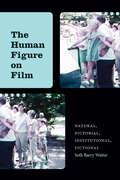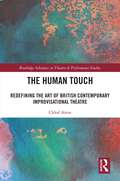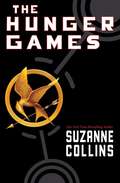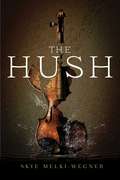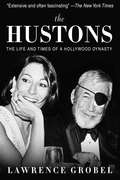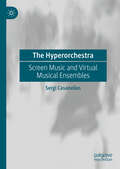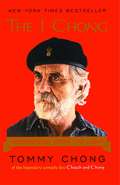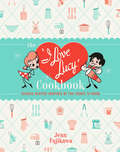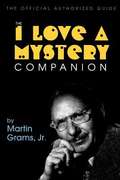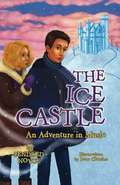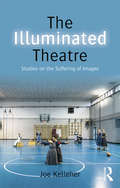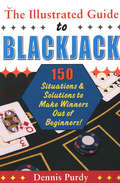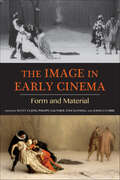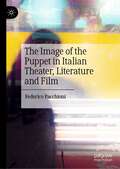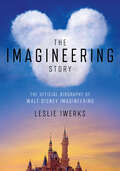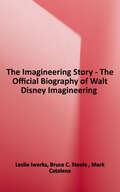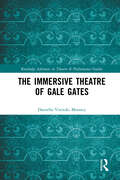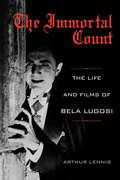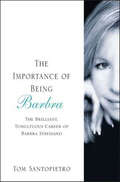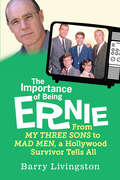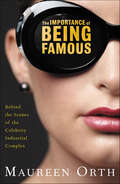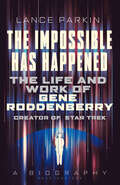- Table View
- List View
The Human Figure on Film: Natural, Pictorial, Institutional, Fictional (SUNY series, Horizons of Cinema)
by Seth Barry WatterThe Human Figure on Film asks what it is we look for when we look at human beings projected on a screen. People have appeared onscreen since film was invented. Nothing could be more common, and yet nothing confounds us more, than a filmed human being. Scholars and critics have attempted to reduce the mystery, creating methodologies that make this figure legible. Some of their efforts form the subject of this book.Each chapter is devoted to a single, central concept—the natural, the pictorial, the institutional, and the fictional—that viewers have used to make sense of what they see. Each concept, in turn, is tied to the work and methods of a particular kind of historical observer: the natural historian (Ray L. Birdwhistell), the aesthete or pictorialist (Victor O. Freeburg), the anthropologist of institutions (Hortense Powdermaker), and the critic of fiction (V. F. Perkins). All of these researchers have their own interests and criteria of understanding, ranging from a microscopic look at gestures to a broad view of characters. Using a combination of critical history, biography, and formal analysis, The Human Figure on Film offers a fresh approach to the problem of figuration in an age of digital cinema. It is, at once, a cross-section of the field of film studies, a handbook of methods, and an inquiry into the nature of inquiry itself.
The Human Touch: Redefining the Art of British Contemporary Improvisational Theatre (ISSN)
by Chloé ArrosThe Human Touch is a book focused on the creative processes at work in British contemporary improvisational theatre and how these processes draw on the humanity of the participants: their cognitive abilities, their lives, and their relationships to each other. Vulnerability is a main feature of both the book and of improvisational theatre, both part of the hurdles that improvisers face and a creative tool. Through a study of improvisation and vulnerability, the book teaches us both what makes improvisational theatre so human and opens the door to a reflection about how to use humanity and human emotions in performance. Most importantly, it delves into the cognitive and physiological processes at work in improvisation, a topic which is missing from most manuals and studies offered to students. This book is addressed to theatre students and provides both an important overview of the form’s history and a challenge to what is usually taught about improvisation.
The Hunger Games (Hunger Games #1)
by Suzanne CollinsNow in paperback, the book no one can stop talking about . . . In the ruins of a place once known as North America lies the nation of Panem, a shining Capitol surrounded by twelve outlying districts.<P><P> The Capitol is harsh and cruel and keeps the other districts in line by forcing them to participate in the annual Hunger Games, a fight-to-the-death on live TV. One boy and one girl between the ages of twelve and sixteen are selected by lottery to play. The winner brings riches and favor to his or her district. But that is nothing compared to what the Capitol wins: one more year of fearful compliance with its rule. Sixteen-year-old Katniss Everdeen, who lives alone with her mother and younger sister, regards it as a death sentence when she is forced to represent her impoverished district in the Games. But Katniss has been close to dead before -- and survival, for her, is second nature. Without really meaning to, she becomes a contender. But if she is to win, she will have to start making choices that weigh survival against humanity and life against love. Acclaimed writer Suzanne Collins, author of the New York Times bestselling Underland Chronicles, delivers equal parts suspense and philosophy, adventure and romance, in this stunning novel set in a future with unsettling parallels to our present.
The Hurt Locker: The Shooting Script (Shooting Script)
by Mark Boal Kathryn BigelowOne of the most critically acclaimed war films in recent memory, The Hurt Locker is a riveting, extraordinary tale of courage and survival on the Baghdad bomb squad, directed by Kathryn Bigelow, from a script by Mark Boal, who researched the material by traveling to the war in Iraq. Boal's screenplay follows the layered, complex relationship between three soldiers who are thrown together in the crucible of combat—with only 38 days left in their tour. Starring Jeremy Renner, Anthony Mackie, Brian Geraghty, and Evangeline Lilly, with Guy Pearce, Ralph Fiennes, and David Morse.This Newmarket Shooting Script® Book includes: Exclusive Introduction by Kathyrn Bigelow Complete shooting script 16-page color insert with 23 color photos Production Notes Storyboards Complete cast and crew credits
The Hush
by Skye Melki-WegnerChester has taken to the road, traveling from village to village desperately searching for his father, who has disappeared. One night while fiddling to earn a few coins, he accidentally connects to the Song-the music that fuels every aspect of the world, and that it’s illegal for him to interact with. He’s caught and sentenced to death for his crime. Only a licensed Songshaper can bend music to his will.But someone in the crowd-a member of the infamous Nightfall Gang-stages a daring rescue and whisks Chester into the Hush, a shadowy nightmare mirror-world where Music can be deadly and Echoes can kill.Susanna, the Captain of the Nightfall Gang has been watching Chester. She needs him to pull off an elaborate plan that will take down the governing body that keeps her an outlaw and made her the fragment she is. Susanna needs him to exact her revenge, even if he dies doing it. Combining complex stakes, shifting loyalties, nods to fairy tales, and a Western feel, The Hush is a lush and exhilarating fantasy perfect for fans of Catherine Fisher’s Incarceron and Paolo Bacigalupi’s Ship Breaker.
The Hustons: The Life and Times of a Hollywood Dynasty
by Lawrence GrobelIn this candid biography Lawrence Grobel chronicles the remarkable story of the Huston family, which boasts three Oscar winners, from Walter to John to Anjelica, with particular attention to the rich career and tumultuous personal life of director/actor John Huston (1906-1987). This updated edition covers Anjelica's stormy relationship with Jack Nicholson, her liberating marriage to artist Robert Graham, the exploits of her brothers Tony and Danny, the mysterious silence of Maricela, John's last love interest and more.
The Hyperorchestra: Screen Music and Virtual Musical Ensembles
by Sergi CasanellesThis book studies the “hyperorchestra” as used in music for the screen and draws from the intersection of practice and theory. The term hyperorchestra derives from hyperreality, a postmodern philosophical concept coined by Jean Baudrillard. The hyperorchestra is a virtual ensemble that inhabits hyperreality. It approaches music spectrally with the aim of becoming a more effective vessel for meaning generation. The book is informed by concepts from postmodern philosophy, such as hyperreality and Marshall McLuhan's theory of media. The book is also informed by the author’s own compositional practice; it describes contemporary processes, current software tools, orchestration and instrumentation principles, and contemporary approaches to music composition (such as spectral music). In doing so, the book proposes a new perspective for analyzing contemporary film music that pinpoints the importance of the relationship between timbre, meaning, and the different narrative levels within an audiovisual piece.
The I Chong: Meditations from the Joint
by Tommy ChongBeloved stoner comedian TOMMY CHONG is now older, wiser, and officially an EX-CON. On the morning of February 24, 2003, agents of the U.S. Drug Enforcement Administration launched a sting called Operation Pipe Dreams and forced themselves through the door of Tommy's California home, with automatic weapons drawn. As a result of the raid on his home; the simultaneous ransacking of his son's company, Chong Glass; and the Bush administration's determination to make an example out of the "Pope of Pot;" he was sentenced to nine months in prison because his company shipped bongs to a head shop in Pennsylvania that was a front for the DEA. Well . . . now it's Tommy Chong's turn to fight back and tell his side of the story. Beginning with Tommy's experiences growing up in Canada in the forties and fifties as a mixed-race kid and going on to become a comedy legend, The I Chong is at once a memoir, a spiritual exploration of his time in prison, and a political indictment of the eroding civil liberties in post-9/11 American society. He tells the unbelievable story of his trip down the rabbit hole of America's war on drugs and of his experiences in the federal prison system, and he offers up timely observations on combating the conservative political forces at work in this country. Introspective, inspiring, and incendiary, The I Chong is a unique chronicle of one man's life and how his humorous and spiritual point of view saved him during his wrongful incarceration at the hands of an administration without boundaries.
The I Love Lucy Cookbook: Classic Recipes Inspired by the Iconic TV Show
by Jenn FujikawaLearn to feast like Lucy, Ricky, Fred, and Ethel and entertain in retro style with this collection of craveable classic recipes inspired by one of the greatest TV shows of all time. Recipes include:Cuban dishes such as Ricky Ricardo's Arroz con Pollo and Tropicana nightclub favoritesChocolate treats and other sweet delicacies inspired by Kramer's Kandy KitchenMid-century Hollywood's finest fare, from episodes set in the sunny film capitalClassic dishes from season three's "The Diner""Pioneer Women" Fresh-Baked Bread (easy on the yeast!)Classic cocktails to toast life's big events -- plus a recipe for Vitameatavegamin, so you can spoon your way to health!The I Love Lucy Cookbook brings to scrumptious life food featured on the show, as well as tantalizing dishes inspired by classic episodes such as "Lucy's Italian Movie," "Job Switching," and "Paris at Last." Filled with photos and illustrations, the book is also an exuberant celebration of an era and unforgettable television moments.
The I Love a Mystery Companion
by Martin Grams Carlton E. MorseI LOVE A MYSTERY is considered one of the most popular radio thrillers of all time. This book documents the history of the radio program, including a section for each and every episode, detailing the adventures of Jack, Doc and Reggie as they go through vampire-infested jungles in "Temple of the Vampires", wind-swept Nevada and even encounter "The Bride of the Werewolf." A superb 400-page book includes memories from cast and crew, illustrations and details about everything related to I LOVE A MYSTERY from the Hollywood movies to the comic books.
The Ice Castle
by Joan Charles Pendred NoyceThe return to Lexicon begins when thirteen-year-old cousins Ivan and Daphne find their Aunt Adelaide deathly ill. Leaving their aunt to rest, Ivan and Daphne accidentally let their younger cousin, Lila, in on their secret world of Lexicon.Ivan and Daphne must track Lila, who disappears, through the frozen landscape to the Land of Winter where social status and freedom is determined by how well one sings. Fortunately for Lila, her musical talent lands her in the most favorable place. Separated by class now, the cousins face the cold, hunger, poverty, illness, injustice, and the malicious plotting of a power-hungry blind man. Slave, servant, and fine lady, the three cousins must escape their own imprisonment before they reunite, provoke a revolution, and restore spring to the Land of Winter.
The Ice Cream Blonde: The Whirlwind Life and Mysterious Death of Screwball Comedienne Thelma Todd
by Michelle MorganA detailed look at the charmed life and tragic death of one of Hollywood's earliest stars A vibrant and beloved Golden Age film comedienne who worked alongside the Marx Brothers, Laurel and Hardy, Ginger Rogers, Cary Grant, Clara Bow, and dozens of others, Thelma Todd was one of the rare actors to successfully cross over from silent films to "talkies." This authoritative new biography traces Todd's life and career, from a vivacious little girl to a young woman who became a reluctant beauty queen to her rapid rise as a Hollywood comedy star to her mysterious death at the age of 29. Increasingly disenchanted with the studio star system, Todd opened the successful Thelma Todd's Sidewalk Café, attracting adoring fans, tourists, and Hollywood celebrities. Life appeared blessed for the beautiful and outspoken Hollywood rebel. So the country was shocked when Todd was found dead by her housekeeper in a garage near the café. An inquest concluded that her death was accidental, caused by inhaling the car's exhaust fumes. In a thorough new investigation that draws on FBI documents, interviews, photographs, reports, and extortion notes--much of these not previously available to the public--author Michelle Morgan offers fresh evidence and conclusions about the circumstances surrounding Todd's death, proving what many people have long suspected, that Thelma had been murdered. The cast of suspects includes Thelma's Hollywood-director lover; her gangster ex-husband; assorted thugs who were pressuring her to install gaming tables in the room above her popular café; and a new, never-before-named mobster. Coinciding with the 80th anniversary of Todd's death, The Ice Cream Blonde is sure to interest any fan of Thelma Todd, Hollywood's Golden Age, or gripping real-life murder mysteries.
The Idea of Nature in Disney Animation: From Snow White to WALL-E (Studies in Childhood, 1700 to the Present)
by David WhitleyIn the second edition of The Idea of Nature in Disney Animation, David Whitley updates his 2008 book to reflect recent developments in Disney and Disney-Pixar animation such as the apocalyptic tale of earth's failed ecosystem, WALL-E. As Whitley has shown, and Disney's newest films continue to demonstrate, the messages animated films convey about the natural world are of crucial importance to their child viewers. Beginning with Snow White, Whitley examines a wide range of Disney's feature animations, in which images of wild nature are central to the narrative. He challenges the notion that the sentimentality of the Disney aesthetic, an oft-criticized aspect of such films as Bambi, The Jungle Book, Pocahontas, Beauty and the Beast, and Finding Nemo, necessarily prevents audiences from developing a critical awareness of contested environmental issues. On the contrary, even as the films communicate the central ideologies of the times in which they were produced, they also express the ambiguities and tensions that underlie these dominant values. In distinguishing among the effects produced by each film and revealing the diverse ways in which images of nature are mediated, Whitley urges us towards a more complex interpretation of the classic Disney canon and makes an important contribution to our understanding of the role popular art plays in shaping the emotions and ideas that are central to contemporary experience.
The Illuminated Theatre: Studies on the Suffering of Images
by Joe KelleherWhat sort of thing is a theatre image? How is it produced and consumed? Who is responsible for the images? Why do the images stay with us when the performance is over? How do we learn to speak of what we see and imagine? And how do we relate what we experience in the theatre to what we share with each other of the world? The Illuminated Theatre is a book about theatricality and spectatorship in the early twenty-first century. In a wide-ranging analysis that draws upon theatrical, visual and philosophical approaches, it asks how spectators and audiences negotiate the complexities and challenges of contemporary experimental performance arts. It is also a book about how European practitioners working across a range of forms, from theatre and performance to dance, opera, film and visual arts, use images to address the complexities of the times in which their work takes place. Through detailed and impassioned accounts of works by artists such as Dickie Beau, Wendy Houstoun, Alvis Hermanis and Romeo Castellucci, along with close readings of experimental theoretical and art writing from Gillian Rose to T.J. Clark and Marie-José Mondzain, the book outlines the historical, aesthetic and political dimensions of a contemporary ‘suffering of images.’
The Illustrated Guide to Blackjack
by Dennis PurdyYou’ve got a pair of jacks. The dealer shows a seven. Do you split or stand? The Illustrated Guide to Blackjack will show you the right move to make in this and every possible blackjack scenario, using real-game situations and solutions that test and hone your skills to the max. Former gambling pro Dennis Purdy not only reveals the best plays for each hand, he shows you why they work, with clear, concise logic, user-friendly charts, and a unique flashcard format that makes each lesson stick. Mastering essential strategy has never been faster or easier. Whether you’re visiting the tables for the first or the fiftieth time, The Illustrated Guide to Blackjack will teach you how to keep on winning, again and again.
The Image in Early Cinema: Form and Material (Early Cinema In Review: Proceedings Of Domitor Ser.)
by Scott Curtis Joshua Yumibe Tom Gunning Philippe GauthierIn The Image in Early Cinema, the contributors examine intersections between early cinematic form, technology, theory, practice, and broader modes of visual culture. They argue that early cinema emerged within a visual culture composed of a variety of traditions in art, science, education, and image making. Even as methods of motion picture production and distribution materialized, they drew from and challenged practices and conventions in other mediums. This rich visual culture produced a complicated, overlapping network of image-making traditions, innovations, and borrowing among painting, tableaux vivants, photography, and other pictorial and projection practices. Using a variety of concepts and theories, the contributors explore these crisscrossing traditions and work against an essentialist notion of media to conceptualize the dynamic interrelationship between images and their context.
The Image of the Puppet in Italian Theater, Literature and Film
by Federico PacchioniWith the advancement of cybernetics, avatars, animation, and virtual reality, a thorough understanding of how the puppet metaphor originates from specific theatrical practices and media is especially relevant today. This book identifies and interprets the aesthetic and cultural significance of the different traditions of the Italian puppet theater in the broader Italian culture and beyond. Grounded in the often-overlooked history of the evolution of several Italian puppetry traditions – the central and northern Italian stringed marionettes, the Sicilian pupi, the glove puppets of the Po Valley, and the Neapolitan Pulcinella – this study examines a broad spectrum of visual, cinematic, literary, and digital texts representative of the functions and themes of the puppet. A systematic analysis of the meanings ascribed to the idea and image of the puppet provides a unique vantage point to observe the perseverance and transformation of its deeper associations, linking premodern, modern, and contemporary contexts.
The Imagineering Story (Disney Editions Deluxe)
by Leslie IwerksThe highly acclaimed and rated Disney+ documentary series, The Imagineering Story, becomes a book that greatly expands the award-winning filmmaker Leslie Iwerks' narrative of the fascinating history of Walt Disney Imagineering.The entire legacy of WDI is covered from day one through future projects with never-before-seen access and insights from people both on the inside and on the outside. So many stories and details were left on the cutting room floor―this book allows an expanded exploration of the magic of Imagineering. So many insider stories are featured. ° Sculptor Blaine Gibson’s wife used to kick him under the table at restaurants for staring at interesting-looking people seated nearby, and he’d even find himself studying faces during Sunday morning worship. “You mean some of these characters might have features that are based on people you went to church with?” Marty Sklar once asked Gibson of the Imagineer's sculpts for Pirates of the Caribbean. “He finally admitted to me that that was true.”° In the early days, Walt Disney Imagineering "was in one little building and everybody parked in the back and you came in through the model shop, and you could see everything that was going on,” recalled Marty Sklar. “When we started on the World’s Fair in 1960 and 1961, we had 100 people here. And so everybody knew everything about what was happening and the status of [each] project, so you really felt like you were part of the whole team whether you were working on that project or not. And, you know, there was so much talent here.” A must-have for Disney Parks fans!Searching for that perfect gift for the #1 Disney fan in your life? Explore more behind-the-scenes stories from Disney Editions:One Little Spark! Mickey's Ten Commandments and The Road to Imagineering (By Disney Legend Marty Sklar)Magic Journey: My Fantastical Walt Disney Imagineering Career (By Kevin Rafferty)Travels with Walt Disney: A Photographic Voyage Around the World (By Jeff Kurtti)Eat Like Walt: The Wonderful World of Disney Food (By Marcy Carriker Smothers)Walt Disney: An American Original (By Bob Thomas)Disney A to Z: The Official Encyclopedia, Fifth Edition (By Disney Legend Dave Smith)
The Imagineering Story: The Official Biography of Walt Disney Imagineering
by Leslie Iwerks Bruce C. Steele Mark CatalenaThe highly acclaimed and rated Disney+ documentary series, The Imagineering Story, becomes a book that greatly expands the award-winning filmmaker Leslie Iwerks' narrative of the fascinating history of Walt Disney Imagineering. The entire legacy of WDI is covered from day one through future projects with never-before-seen access and insights from people both on the inside and on the outside. So many stories and details were left on the cutting room floor--this book allows an expanded exploration of the magic of Imagineering. So many insider stories are featured. - Sculptor Blaine Gibson's wife used to kick him under the table at restaurants for staring at interesting-looking people seated nearby, and he'd even find himself studying faces during Sunday morning worship. "You mean some of these characters might have features that are based on people you went to church with?" Marty Sklar once asked Gibson of the Imagineer's sculpts for Pirates of the Caribbean. "He finally admitted to me that that was true." - In the early days, Walt Disney Imagineering was in one little building and everybody parked in the back and you came in through the model shop, and you could see everything that was going on,"" recalled Marty Sklar. "When we started on the World's Fair in 1960 and 1961, we had 100 people here. And so everybody knew everything about what was happening and the status of each project, so you really felt like you were part of the whole team, whether you were working on that project or not. And, you know, there was so much talent here.
The Immersive Theatre of GAle GAtes (Routledge Advances in Theatre & Performance Studies)
by Daniella Vinitski MooneyThis book focuses on experimental theatre company, GAle GAtes, credited as "the true innovator" of the contemporary immersive movement. The Immersive Theatre of GAle GAtes is a case-study of this little-known but visionary company, with a focus on its development and dramaturgy. Through rare archival and primary research, as well as historical context, the text chronicles company narrative and celebrates the artistic impulse. The book employs descriptive-narrative and dramaturgical analysis and is composed of historical research, rare archives, and primary source interviews. Chapters focus on the trajectory of the avant-garde leading up to the climate in which the company formed, company formative years, and major works and a discussion on the interdisciplinary and theoretical frameworks critical to its understanding. This study will be of great interest to students and scholars in theatre and performance studies and essential reading for theatre artist and historian alike, with a focus on the experimental theatre landscape.
The Immortal Count: The Life and Films of Bela Lugosi
by Arthur LennigThis definitive biography of the silver screen legend is &“a moving, lively, witty, sad book that revives once more the long dead Count Dracula&” (Kirkus Reviews). Bela Lugosi won immediate fame for his starring role in the 1931 film Dracula—the role that would forever define his persona. After a decade of trying to broaden his range, Lugosi resigned himself to a career as the world's most recognizable vampire, often playing opposite his horror film rival Boris Karloff. When he died in 1956, Lugosi could not have known that vindication of his talent would come—his face would adorn theaters and his Hungarian accent would be instantly recognized across the globe. In 1974, silent film expert Arthur Lennig published The Count, a highly regarded biography of the unsung actor. Now Lennig returns to his subject with a completely revised volume more than twice the length of the original. The Immortal Count provides deeper insights into Lugosi's films and personality. Drawing upon personal interviews, studio memos, shooting scripts, research in Romania and Hungary, and his own recollections, Lennig has written the definitive account of Lugosi's tragic life.
The Importance of Being Barbra: The Brilliant, Tumultuous Career of Barbra Streisand
by Tom SantopietroControversial, a global icon, a diva among divas---Barbra Streisand, the last genuinely unique show business personality of the twentieth century is the most honored entertainer in the world today. But along with the Tony, two Oscars, six Emmys, eight Grammys, ten Golden Globes, fifty gold albums, and wild acclaim have come wildly diverse reactions to a personality as outsized as her talent. In the words of Streisand herself, "I'm a liberal, opinionated Jewish feminist---I push a lot of buttons." In Tom Santopietro's witty yet analytical look at this one-of-a-kind career, the myths and personal foibles are stripped away, and the focus lands squarely on the work. From the early recordings to the groundbreaking television specials, from the Hollywood blockbusters to the history-making comeback concerts, Streisand's career is placed within an oftentimes uniquely American social context but always allowed to speak for itself. In a brisk, funny, and always compelling style, The Importance of Being Barbra reveals all the milestones in a new and sometimes startling light, ranging from the brilliance of Funny Girl and The Broadway Album to the misbegotten yet curiously popular A Star Is Born.Treating Barbra Streisand like the serious artist she is---and has always claimed to be---The Importance of Being Barbra delves into the key reasons for her all-encompassing success: the overwhelming ambition, the notorious perfectionism, the fervent gay following, the dramatic pull of a voice and style that mysteriously connect with the lovelorn all around the world. A full-scale examination of the acting, singing, and directing that have ranged from the dazzling to the occasionally inexplicable---it's all here for anyone who has ever wondered at the phenomenon that is Barbra Streisand.
The Importance of Being Ernie: From My Three Sons to Mad Men, a Hollywood Survivor Tells All
by Barry LivingstonI SPENT MY ENTIRE LIFE PLAYING NERDS. . .—Barry Livingston A true Hollywood survivor, Barry Livingston is one of the few child stars who turned early success into a lifelong career. As "Ernie" on the 1960s sit-com My Three Sons—which also featured his real-life brother Stanley as "Chip"—Barry become instantly recognizable for his horn-rimmed glasses and goofy charm. Five decades later, after working on TV shows like Mad Men and Desperate Housewives, and in feature films like Zodiac and The Social Network, Barry Livingston is one actor who knows The Importance of Being Ernie. . . In this fascinating and funny memoir, Barry reveals his most unforgettable anecdotes: Working on set with Fred McMurray, Ozzie and Harriet, Lucille Ball and Dick Van Dyke. Riding a limousine with Elvis Presley. Trying to upstage Ron "Opie" Howard. Even shooting a Superbowl beer commercial with Brad Pitt. At first, Barry's lazy eye and horn-rimmed glasses nearly derailed his career, getting him kicked off his first major film starring Paul Newman. Eventually, his "nerdy" look became his biggest asset, landing Barry a recurring role on Ozzie & Harriet and a regular part on My Three Sons. Fifty years later, Barry is still going strong—from the stage and small screen to to featured film roles opposite Adam Sandler and Robert Downey, Jr.. Like most Hollywood actors, Barry experienced some incredible highs and lows along the way, but he never gave up. "I've been around half a century," he affirms. "And I'm not going away." This is how one child star beat the odds and survived the dark side of the Hollywood dream factory—with charm, wit, determination. . .and big horn-rimmed glasses. This is The Importance of Being Ernie.Barry Livingston has been a professional actor on stage and screen for more than fifty years. Best known for his role as "Ernie" on the long-running TV program, My Three Sons, Livingston continues to appear regularly in feature films and television shows. He is married with two children, and lives in Los Angeles.Praise For The Importance Of Being Ernie "This wryly told saga of a child star who miraculously avoided the crash-and-burn fate of so many of the once-famous. . . an engaging tale of the unusual life of a humorous, modest, and observant man. Barry Livingston delivers a frank and funny tale of TV, movies, and family life." —Brent Maddock, co-author of Tremors and Short Circuit "For a child star, he's almost normal. This poor kid had to sit on William Frawley's lap; we're lucky he's not on a roof with a rifle. . .. Barry is one of those rare child stars who grew up to become an accomplished adult actor. Having logged fifty years in show business, working with everyone from Lucille Ball and Jack Benny to Brad Pitt and Robert Downey, Jr., he's got a great story to tell." —Paul Jackson, Producer Charmed and Sliders. "I have known Barry Livingston since he was nine years old. He always made me laugh. Now he's kept me awake reading his wonderful autobiography. There's a lot of talent in those size eight shoes." —Gene Reynolds, director of TV's M.A.S.H.and Promised Land
The Importance of Being Famous: Behind the Scenes of the Celebrity Industrial Complex
by Maureen OrthVanity Fair's veteran special correspondent pulls back the curtain on the world of celebrity and those who live and die thereVanity Fair's Maureen Orth always makes news. From Hollywood to murder trials to the corridors of politics, this National Magazine Award winner covers lives led in public, on camera, in the headlines. Here she takes us close-up into the world of fame--bridging entertainment, politics, and news--and the lives of those who understand the chemistry, the very DNA, of fame and how to create it, manipulate it, sustain it. Moving from former Prime Minister Margaret Thatcher to Michael Jackson, the ultimate child/monster of show business, Orth describes our evolution from a society where talent attracted attention to a place where the star-making machinery of the "celebrity-industrial complex" shapes, reshapes, and sells its gods (and monsters) to the public. From divas letting their hair down (Tina Turner) to Little Gods (Woody Allen and Princess Diana's almost father-in-law Mohammed Fayed), political theater (Arnold's Hollywood hubris, Arianna Huffington's guru-guided gubernatorial quest), news-gone-soap-opera (I Love Laci), and even the Queen Mother of reinvention (Madonna as dominatrix/children's-book author), Orth delivers a portrait of an era. The Importance of Being Famous shows us the real world of the big room where the rules that govern mere mortals don't matter--and anonymity is a crime.
The Impossible Has Happened: The Life and Work of Gene Roddenberry, Creator of Star Trek
by Lance ParkinA biographer goes in search of Gene Roddenberry, creator of the world’s most successful science fiction franchise.This book reveals how an undistinguished writer of cop shows set out to produce “Hornblower in space” —and ended up with Star Trek, an optimistic, almost utopian view of humanity’s future that has been watched and loved by hundreds of millions of people around the world.Along the way, Lance Parkin examines some of the great myths and turning points in the franchise’s history, and Roddenberry’s particular contribution to them. He looks at the view that the early Star Trek advanced a liberal, egalitarian, and multi-racial agenda; charts the various attempts to resuscitate the show during its wilderness years in the 1970s; explores Roddenberry’s initial early involvement in the movies and spin-off Star Trek: The Next Generation (as well as his later estrangement from both), and sheds light on the colorful personal life, self-mythologizing, and strange beliefs of a man who nonetheless gifted popular culture one if its most enduring narratives.
